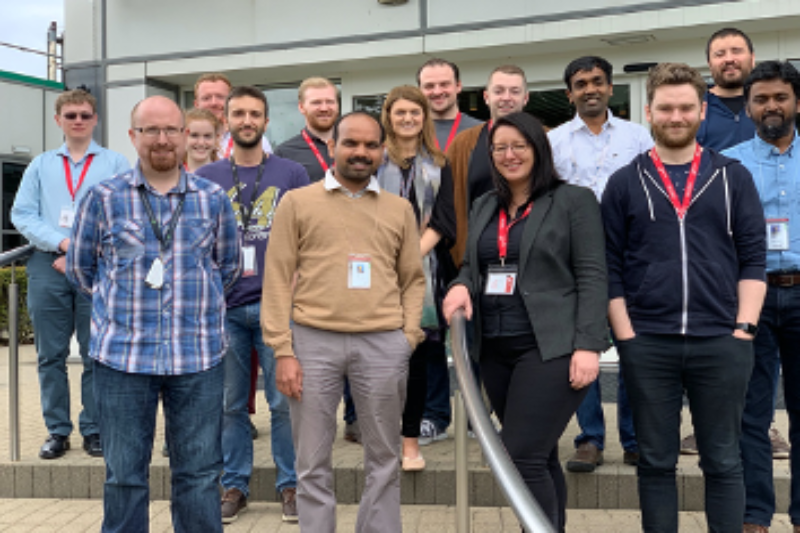Advanced Materials for Data Storage
Professor Robert Bowman REng

Cloud storage is rapidly growing because we all, as individuals, companies, organisations and governments, rely on data centres filled with large numbers of 'server' computers using hard disk drives (HDDs) to store personal and societal digital information. One server is required for every 600 smartphones or 120 tablet computers, and trends such as Industry 4.0 and the Internet of Things are generating yet more new data, so the Cloud will continue to grow rapidly. The Cloud accounted for 25% of storage in 2010 and will account for >60% by 2020. As a result of these trends, the Cloud storage market is growing at 30% p.a. and is expected to be worth nearly $100b by 2022. While almost all personal computing and related electronic devices have migrated to solid state drives (SSD), HDDs are the only viable technology for cloud storage and a step change in the capacity of HDDs is required.
Due to the limitations of existing magnetic materials, a new technology is needed to increase the density of magnetic data recording beyond the current 1Tb/sq. inch out to well beyond 10Tb/sq. inch and meet the 30% annual growth rate. Heat- assisted magnetic recording (HAMR) has been identified to overcome physical challenges and has now demonstrated proof of principle.
HAMR requires the integration of photonic components including lasers, waveguides and plasmonic antennas within the current magnetic recording head transducer, in which the magnetic materials/structures have also to be developed further. With a total addressable market (TAM) of 400-600 million hard disk drives p.a. with 3-4 heads per drive, HAMR is projected to require 2+ billion diode lasers p.a. & become the largest single market for laser diodes and photonic integration. Its successful development will also drive low-cost photonic integration and plasmonic technology into other industries and applications.
Our partner, Seagate Technology, has a major manufacturing site here, in Derry, employing 1400 staff and around 150 of those in R&D working on HAMR. Arguably the read/write head is the most sophisticated manufactured item made in the UK - their need to find new materials and structures drives this collaborative programme working from fundamental magnetic materials like rare earths, through imaging of parts of the magnetic device to the development of new plasmonic materials and structures for HAMR.
A most significant aspect of the QUB-Seagate partnership has now burgeoned to include and stimulate academic and industrial collaborations across the UK & Ireland to support this opportunity.
As well as undertaking fundamental and applied materials research in magnetic and optical/plasmonic materials at TRL 1-3 with results communicated in scientific literature [1] and of IPR value [2] the partnership with Seagate has also been about driving a wider advanced materials / photonics ecosystem. The ANSIN advanced materials hub help enable the spin out Causeway Sensors Ltd. who are developing a nanostructure for therapeutics manufacturing.
The ANSIN facility was also the basis for the establishment of the EPSRC Centre for Doctoral Training in Photonic Integration & Advanced Data Storage in 2014 in collaboration with the University of Glasgow http://www.cdt-piads.ac.uk which also drew support from a dozen companies in the UK that could form part of a supply chain towards Seagate Technology’s HAMR activities. It will train 50 PhDs. In 2019 an additional partnership with the Irish Photonic Integration Centre led to the formation of the EPSRC-SFI Centre for Doctoral Training in Photonic Integration & Advanced Data Storage expanding our ecosystem to over a dozen companies to train a further 75 PhD/EngD through to 2027.
Most recently the partnership is at the core of a new consortia the Smart Nano - manufacturing Corridor who have progressed to full proposal development wave 2 of the UKRI Strength in Places Fund https://www.ukri.org/funding/funding-opportunities/strength-in-places-fund/wave-2-seedcorn-funded-proposals/
[1] A review of high magnetic moment thin films for microscale and nanotechnology applications Applied Physics Reviews 3, 011301 (2016); https://doi.org/10.1063/1.4941311
[2] Storage device head using high magnetic moment material including a rare earth material and a transition metal US9773512B2.

Caption: Seagate Technology Sponsored CDT students at the Springtown site for meeting with mentors
In 2010 Seagate Technology provided some £1.6M along with £7.5M of donated capital equipment to established Ansin, an advanced materials hub (https://www.bbc.co.uk/news/10267681 ). Since then they have invested over £2M. to support research and develop new programmes.
 The work has led to partnership with the University of Glasgow and a dozen UK companies for the establishment of the EPSRC Centre for Doctoral Training in Photonic Integration & Advanced Data Storage www.cdt-piads.ac.uk (https://gow.epsrc.ukri.org/NGBOViewGrant.aspx?GrantRef=EP/L015323/1 ) and comprised and investment by all of some £8.2M delivering fifty PhD scientists and engineers This was successfully renewed in 2018 and we added the partnership of Science Foundation Ireland (SFI) Irish Photonic Integration Centre www.ipic.ie at the Tyndall National Institute, Cork Ireland to become the EPSRC & SFI Centre for Doctoral Training in Photonic Integration & Advanced Data Storage (https://gow.epsrc.ukri.org/NGBOViewGrant.aspx?GrantRef=EP/S023321/1 ) to delivery seventy five PhD/EngD scientists and engineers in a £13M investment through to 2028.
The work has led to partnership with the University of Glasgow and a dozen UK companies for the establishment of the EPSRC Centre for Doctoral Training in Photonic Integration & Advanced Data Storage www.cdt-piads.ac.uk (https://gow.epsrc.ukri.org/NGBOViewGrant.aspx?GrantRef=EP/L015323/1 ) and comprised and investment by all of some £8.2M delivering fifty PhD scientists and engineers This was successfully renewed in 2018 and we added the partnership of Science Foundation Ireland (SFI) Irish Photonic Integration Centre www.ipic.ie at the Tyndall National Institute, Cork Ireland to become the EPSRC & SFI Centre for Doctoral Training in Photonic Integration & Advanced Data Storage (https://gow.epsrc.ukri.org/NGBOViewGrant.aspx?GrantRef=EP/S023321/1 ) to delivery seventy five PhD/EngD scientists and engineers in a £13M investment through to 2028.
In 2017 Professor Bowman was awarded the Seagate Technology / Royal Academy of Engineering Research Chair in Advanced Materials for Data Storage.
